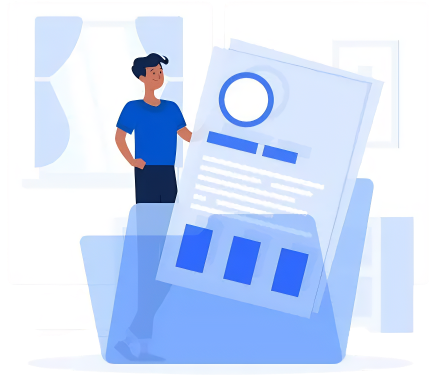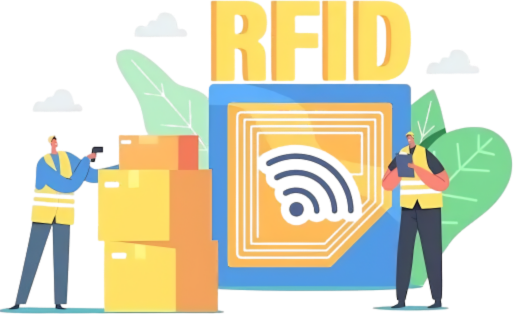Introduction
Asset tracking is a critical concern for businesses of all sizes, and with good reason. Workplace asset theft alone costs organizations up to $50 billion per year. Nearly half of small companies still rely on manual methods (or none at all) to track their assets. This leads to lost equipment, wasted time, and compliance risks.
Dive into our guide on using barcodes and QR codes for efficient asset tracking.
The barcode vs RFID asset tracking debate often comes up when companies look to modernize their tracking. Now GPS-based tracking adds another option for field assets. So which method is best for your needs? In this post, we compare barcodes (including QR codes), RFID, and GPS for asset management. We’ll highlight each technology’s pros, cons, and ideal use cases so you can make an informed decision.

Curious How Asset Tagging Works?
From tag placement to real-time scanning and reporting—see the full journey of smarter asset management in action.

Curious How Asset Tagging Works?
From tag placement to real-time scanning and reporting—see the full journey of smarter asset management in action.
Barcodes & QR Codes – Cost-Effective Asset Tracking
Barcodes (1D) and QR codes (2D) are the simplest and most budget-friendly asset tracking method. These printed optical labels store an identifier for each asset. Scanning one with a reader or smartphone app pulls up that asset’s record in your system.
Pros:
Barcodes and QR codes are extremely cheap to implement and very accurate. Each scan reliably pulls up the right item, virtually eliminating manual data errors. This method is also simple for employees to use and requires no power. Labels often last for years if kept in good condition.
Cons:
Barcodes require direct line-of-sight scanning. A worker must scan each label individually, which is time‑consuming for large inventories. They also can’t be read through obstacles (unlike RFID tags) and carry only a basic ID (no extra data). Additionally, labels are easily damaged—a smudged or torn barcode can become unreadable.
Use Cases:
Barcodes and QR codes are ideal for static or indoor assets on tight budgets. They’re common in offices, schools, warehouses, and used for periodic audits. Retail stores and libraries scan low-cost items individually as needed. If assets stay put and need occasional checks, barcodes offer a simple, reliable solution.

RFID Asset Tracking – Automation & Mid-Range Efficiency
RFID (Radio-Frequency Identification) uses radio waves to identify tagged assets without needing a direct scan of each one. A reader can detect multiple RFID tags within range (often up to 10–30 feet for passive tags). It can pick them up even if they’re hidden in a box or behind other objects.
When considering RFID vs QR code asset tracking, the key difference is automation. An RFID reader can scan dozens of tags in seconds with no manual effort. By contrast, QR codes have to be read one by one. Each RFID tag has a tiny chip and antenna that transmits a unique ID when it comes near a reader.

Pros:
RFID’s biggest advantage is fast, automated scanning across large areas. It can inventory multiple assets in seconds without direct line-of-sight. Durable RFID tags withstand harsh environments and can be embedded in equipment. Some tags also store data like maintenance history, updated wirelessly.
Cons:
RFID systems are more expensive and complex to deploy than barcodes. Also, tags cost more per item than printed labels. RFID readers and infrastructure are also far pricier than basic barcode scanners. Implementing RFID also requires careful setup and training. You’ll need to tag all items, install readers, and integrate the software. Additionally, radio signals can be finicky—metal or liquids may disrupt reads, so an RFID system isn’t always 100% reliable.
Use Cases:
RFID is best for situations that demand automation and rapid scanning of many items. It shines in large warehouses or storerooms. Staff can inventory dozens of assets in seconds without scanning each item individually. Companies often use RFID to track high-movement inventory, pallets, or tools in bulk—scenarios where barcodes would be far too slow.
Get a Customized RFID Asset Tracking Quote
Ready to streamline your asset management? Our team will assess your needs and deliver a tailored RFID solution.
Get a Customized RFID Asset Tracking Quote
Ready to streamline your asset management? Our team will assess your needs and deliver a tailored RFID solution.
GPS Asset Tracking – Real-Time Location for Field Assets
GPS asset tracking uses satellite signals and cellular networks to provide continuous, real-time location data over a wide area. A GPS tracker is a device attached to an asset (for example, a vehicle or piece of equipment). It determines the asset’s coordinates via satellite and transmits that data to a software platform.
This method is different from barcodes or RFID, which only tell you an asset’s location when someone scans it on-site. In a barcode tracking versus GPS comparison, a barcode logs an asset’s location only at the point of scan. By contrast, GPS can continuously stream an asset’s location as it moves across distance.
Pros:
The biggest benefit of GPS tracking is real-time, anywhere visibility for your assets. A GPS unit on an asset continuously reports its location to a central system. That way, you can always see where your vehicles or equipment are. There’s effectively no range limit — unlike RFID or barcodes that need nearby scanners. GPS can track assets across cities or even countries. If a valuable asset is stolen or goes off-course, you can pinpoint its location for quick recovery.
Cons:
GPS tracking is the most expensive option and requires a power source for each device. Each tracker may cost $100–$300 and requires a battery or wired power, plus a data subscription for connectivity. GPS also needs a clear view of the sky to work, so it won’t function indoors or underground. In short, GPS is usually overkill for stationary or on-site assets. It only makes sense for assets that travel widely and absolutely need live tracking.
Use Cases:
GPS tracking is ideal for mobile, high-value assets like fleet vehicles, construction equipment, and shipments. Many companies use GPS units on trucks and heavy machinery for real-time location and theft prevention. It ensures continuous oversight for assets on the move. As per the research, GPS tracking is widely adopted across industries to enhance visibility, improve control, and streamline operations.

How to Choose the Right Asset Tracking Method
Asset Volume & Scale:
If you have a large number of small or low-value items, barcodes or QR codes are usually the most practical choice. If you manage hundreds of assets in a large facility and need to audit them often, consider RFID. Its bulk-scanning ability can save enormous time. Meanwhile, for a few extremely valuable assets that roam over wide distances, investing in GPS trackers might be sensible.
Range of Tracking Needed:
For assets confined to a single site or building, barcodes or RFID will cover the basics. If you need to track assets across long distances (e.g. between cities or countries), only GPS (or similar IoT trackers) can provide that kind of reach. Barcodes and passive RFID require someone near the asset to scan it. In contrast, GPS lets you monitor an asset’s location remotely over a virtually unlimited range.
Budget and ROI:
Cost is often the deciding factor when choosing tracking technology. Barcodes are the cheapest, needing only printed labels and basic scanners. RFID costs more upfront but saves labor and reduces errors long-term. GPS is the most expensive, suited for high-value assets needing real-time visibility.
Explore how to choose the best barcode asset tracking software>>
Not sure which asset tracking solution fits your needs?
Talk to our experts for a personalized recommendation based on your specific scenario.
Not sure which asset tracking solution fits your needs?
Talk to our experts for a personalized recommendation based on your specific scenario.
FAQs
Q1: Will RFID replace barcodes?
Ans: Not entirely. RFID brings speed and automation, making it a great fit for warehouses, logistics, and large-scale operations. However, barcodes remain the most cost-effective and practical choice for many businesses. Since barcodes are easy to print, cheap to deploy, and simple to use, they won’t disappear anytime soon. Instead of RFID replacing barcodes, most organizations benefit from using both barcodes for low-cost or static assets and RFID for high-movement or bulk items.
Q2: Does a barcode have an expiry date?
Ans: No, barcodes don’t come with an expiry date. The information inside a barcode stays valid indefinitely. What can “expire” is the physical label itself—if it fades, gets scratched, or is printed on poor-quality material, scanners may not read it properly. For long-term use, businesses often choose durable barcode labels made of laminated, polyester, or even metal materials to ensure consistent readability.
Conclusion
There’s no one-size-fits-all solution in the barcodes vs RFID vs GPS debate. Barcodes and QR codes offer a cost-effective, accurate way to manage fixed assets. RFID enables automation through bulk scanning and hands-free tracking for fast operations. GPS tracking provides real-time visibility of mobile or high-value assets anywhere.
Ultimately, the best asset tracking method depends on your specific needs, budget, and the nature of your assets. In many cases, a hybrid approach (for example, using barcodes and RFID on-site, plus GPS for field assets) works best. Modern asset management solutions like AssetCues support all these technologies on one platform, letting you mix and match methods seamlessly. By leveraging the right combination of tools, you can secure your assets, streamline audits, and gain full visibility into your operations. This will help make lost or mismanaged assets a thing of the past.
About Author






